Related Research Articles

A narrow-gauge railway is a railway with a track gauge narrower than 1,435 mmstandard gauge. Most narrow-gauge railways are between 600 mm and 1,067 mm.

Rail transport is a means of transport using wheeled vehicles running in tracks, which usually consist of two parallel steel rails. Rail transport is one of the two primary means of land transport, next to road transport. It is used for about 8% of passenger and freight transport globally, thanks to its energy efficiency and potentially high speed.

A train is a series of connected vehicles that run along a railway track and transport people or freight. Trains are typically pulled or pushed by locomotives, though some are self-propelled, such as multiple units or railcars. Passengers and cargo are carried in railroad cars, also known as wagons or carriages. Trains are designed to a certain gauge, or distance between rails. Most trains operate on steel tracks with steel wheels, the low friction of which makes them more efficient than other forms of transport.

A steam locomotive is a locomotive that provides the force to move itself and other vehicles by means of the expansion of steam. It is fuelled by burning combustible material to heat water in the locomotive's boiler to the point where it becomes gaseous and its volume increases 1,700 times. Functionally, it is a steam engine on wheels.

The history of rail transport began before the beginning of the common era. It can be divided into several discrete periods defined by the principal means of track material and motive power used.

A tender or coal-car is a special rail vehicle hauled by a steam locomotive containing its fuel and water. Steam locomotives consume large quantities of water compared to the quantity of fuel, so their tenders are necessary to keep them running over long distances. A locomotive that pulls a tender is called a tender locomotive. Locomotives that do not have tenders and carry all their fuel and water on board the locomotive itself are called tank locomotives or tank engines.
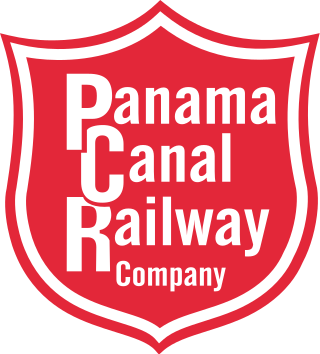
The Panama Canal Railway is a railway line linking the Atlantic Ocean to the Pacific Ocean in Central America. The route stretches 47.6 miles (76.6 km) across the Isthmus of Panama from Colón (Atlantic) to Balboa. Because of the difficult physical conditions of the route and state of technology, the construction was renowned as an international engineering achievement, one that cost US$8 million and the lives of an estimated 5,000 to 10,000 workers. Opened in 1855, the railway preceded the Panama Canal by half a century; the railway was vital in assisting the construction of the canal in the early 1900s. With the opening of the canal, the railroad's route was changed as a result of the creation of Gatun Lake, which flooded part of the original route. Following World War II, the railroad's importance declined and much of it fell into a state of neglect until 1998, when a project to rebuild the railroad to haul intermodal traffic began; the new railroad opened in 2001.

Railroads played a large role in the development of the United States from the industrial revolution in the Northeast (1820s–1850s) to the settlement of the West (1850s–1890s). The American railroad mania began with the founding of the first passenger and freight line in the country, the Baltimore and Ohio Railroad, in 1827, and the "Laying of the First Stone" ceremonies and the beginning of its long construction heading westward over the obstacles of the Appalachian Mountains eastern chain in the next year. It flourished with continuous railway building projects for the next 45 years until the financial Panic of 1873, followed by a major economic depression, that bankrupted many companies and temporarily stymied and ended growth.
Under the Whyte notation for the classification of steam locomotives, 2-10-2 represents the wheel arrangement of two leading wheels, ten powered and coupled driving wheels, and two trailing wheels. In the United States and elsewhere the 2-10-2 is known as the Santa Fe type, after the Atchison, Topeka and Santa Fe Railway that first used the type in 1903.
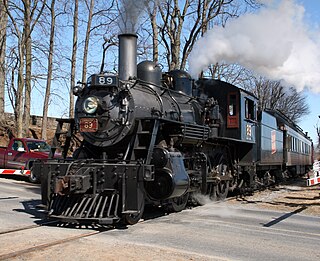
Under the Whyte notation for the classification of steam locomotives, 2-6-0 represents the wheel arrangement of two leading wheels on one axle, usually in a leading truck, six powered and coupled driving wheels on three axles and no trailing wheels. This arrangement is commonly called a Mogul.
The Champlain and St. Lawrence Railroad (C&SL) was a historic railway in Lower Canada, the first Canadian public railway and one of the first railways built in British North America.
In 1948, 14 railroads in North America owned more than 1,000 steam locomotives each. See also: Historical sizes of railroads

This is a list of the earliest railroads in North America, including various railroad-like precursors to the general modern form of a company or government agency operating locomotive-drawn trains on metal tracks.
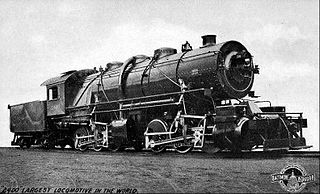
Under the Whyte notation for the classification of steam locomotives, a 0-6-6-0 wheel arrangement refers to a locomotive with two engine units mounted under a rigid locomotive frame, with the front engine unit pivoting and each engine unit with six coupled driving wheels without any leading or trailing wheels. The wheel arrangement was mostly used to describe Mallet locomotive types and in some occasions, Double Fairlie locomotives.

Dieselisation is the process of equipping vehicles with a diesel engine or diesel engines.

The Trona Railway is a 30.5 mi (49.1 km) short-line railroad owned by Searles Valley Minerals. The TRC interchanges with the Lone Pine Subdivision of the Union Pacific Railroad at Searles, California.
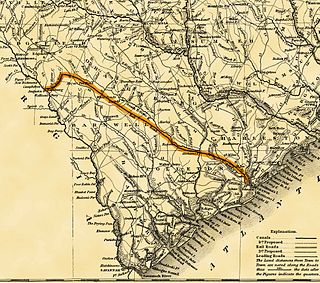
The South Carolina Canal and Rail Road Company was a railroad in South Carolina that operated independently from 1830 to 1844. One of the first railroads in North America to be chartered and constructed, it provided the first steam-powered, scheduled passenger train service in the United States.
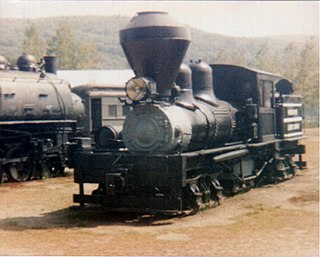
Steamtown, U.S.A., was a steam locomotive museum that ran steam excursions out of North Walpole, New Hampshire, and Bellows Falls, Vermont, from the 1960s to 1983. The museum was founded by millionaire seafood industrialist F. Nelson Blount. The non-profit Steamtown Foundation took over operations following his death in 1967. Because of Vermont's air quality regulations restricting steam excursions, declining visitor attendance, and disputes over the use of track, some pieces of the collection were relocated to Scranton, Pennsylvania in the mid-1980s and the rest were auctioned off. After the move, Steamtown continued to operate in Scranton but failed to attract the expected 200,000–400,000 visitors. Within two years the tourist attraction was facing bankruptcy, and more pieces of the collection were sold to pay off debt.

The GE 25-ton switcher is a model of diesel-electric switcher locomotive that was produced by GE Transportation at their Erie, Pennsylvania, facility between 1941 and 1974. Most examples were produced for industrial customers or the United States Armed Forces, although a number of examples were purchased by freight railroads as well. The majority of production was for customers in the United States and Canada, but export models were produced for buyers on five continents. Production totaled approximately 550 units over 33 years, making it one of the most widely produced switchers in American history.
References
- Bruce, Alfred W. (1952) The Steam Locomotive in America: Its Development in the Twentieth Century, New York, Bonanza Books, Table 6, plus additional material from text for Canadian Railroads.